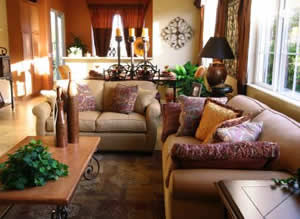
Ethnic traditions, customs, and attitudes carry forward our family values. Paying tribute to family heritage and tradition also gives our children a strong sense of family ties. Our roots make us what we are, and showing respect for ancestral traditions gives the interior of your home a special individuality.
Vernacular Heritage
Regional architecture, called the vernacular, designs structures to harmonize and blend with the environment. Designed to reflect the past, using historical influences, vernacular houses complement rather than dominate their settings. These homes recreate the traditional neighborhoods of the past with a strong sense of place.
Many vernacular structures provide friendly zones and foster a relaxed lifestyle. For instance, Santa Fe stucco and adobe block homes often have central courtyards. Friendly porches customarily found on Florida cracker houses invite neighborly chats. Key West’s wood-framed "conch houses" and North Carolina’s "low country" houses feature broad verandahs and large windows to take advantage of the area’s cooling breezes.
Vernacular homes provide sheltering transitional space from the outside to the inside, but homes without such transitional spaces can benefit greatly when structural or landscaping details are added to bring the private interior space of the home into harmony with the outside world. If your home lacks a covered entry, consider adding a wood or iron framework or an awning to create a feeling of protection and shelter.
Ethnic Influence on American Architecture and Furnishings
Since Americans have always constructed houses that mimicked their native homelands, it’s not surprising that Italian and Mediterranean villas, grand English country houses, and simple French farmhouses can be found across the United States. From the earliest days of our nation, Americans have taken design details from all over the world and copied, adapted, and redesigned their ethnic patterns and furnishings.
Patterns originating in Africa, such as animal prints and intricate geometrics, have been duplicated in many ways. Mexican antiques, Danish and Swedish furniture, and Oriental-influenced accessories have intermingled in our homes. From New England Cape Cods to Santa Fe adobes, our diverse heritage has influenced American architecture and interior design, while log cabins, rustic western interiors, and American folk art have suggested distinct American origins.
Style and Emotional Ambience
Style is the end decorating result of the combination of detail characteristics reminiscent of an era, an artistic movement, or a particular region, such as the Victorian era, Art Nouveau period, or Midwestern Prairie style. Mood or emotional ambiance is the personal interpretation of style to evoke feelings, whether they are cleanly slick, elegantly formal, cozily informal, or romantically eclectic.
Architectural Styles: Structure and Furnishings
Rooms all of one period or style are best left for museums or exhibitions. Eclectic rooms mix furnishings from different periods, such as a contemporary sofa, a silver maple Chippendale side table, and a gilded Louis XVI mirror. The beautiful and the bizarre, the exquisite and the commonplace, mixed with frivolity and delight, create joyful homes.
Architectural style may refer to a structure or to a type of furnishing. Mixing period styles with today’s lifestyles is called New Traditionalism. Combination of styles with a light– hearted flair create elegant, unpretentious rooms. A few grand pieces, interspersed with simple furnishings, will bring informality to an otherwise stodgy home.
Architectural style also influences interior design. Understand the architectural style of your home and use it as a reference point for your decorating. In my own case, our modern furniture looked totally out of place in our 1878 home, so we traded our glass dining table for a traditional wood one, and replaced a modular sofa with a squishy antique one.
Some Victorian homes look magnificent when furnished with contemporary furniture, but this is harder to accomplish than the reverse, which is a contemporary house, furnished with antiques. Grand old houses decorated with modern furnishings look better with plain, simple wall finishes and un-frilled window coverings.
Juxtaposing styles from your heritage with other styles that suit your fancy makes for interesting rooms and homes. Not all rooms in your home need to incorporate the same style, but some blending from room to room ensures harmony. Mixing heritage styles according to those who share your home also creates a harmonizing aura.
Your Personal Style
If you have a strong affinity for a particular architectural style, incorporate it into your total design plan. Encourage respect for your family traditions by surrounding yourself with ethnic furnishings and family heirlooms. Any style can be adapted to your way of living, whether it’s serenely sleek, traditionally formal, or casually informal, by either dressing up or paring down your decorating embellishments.








